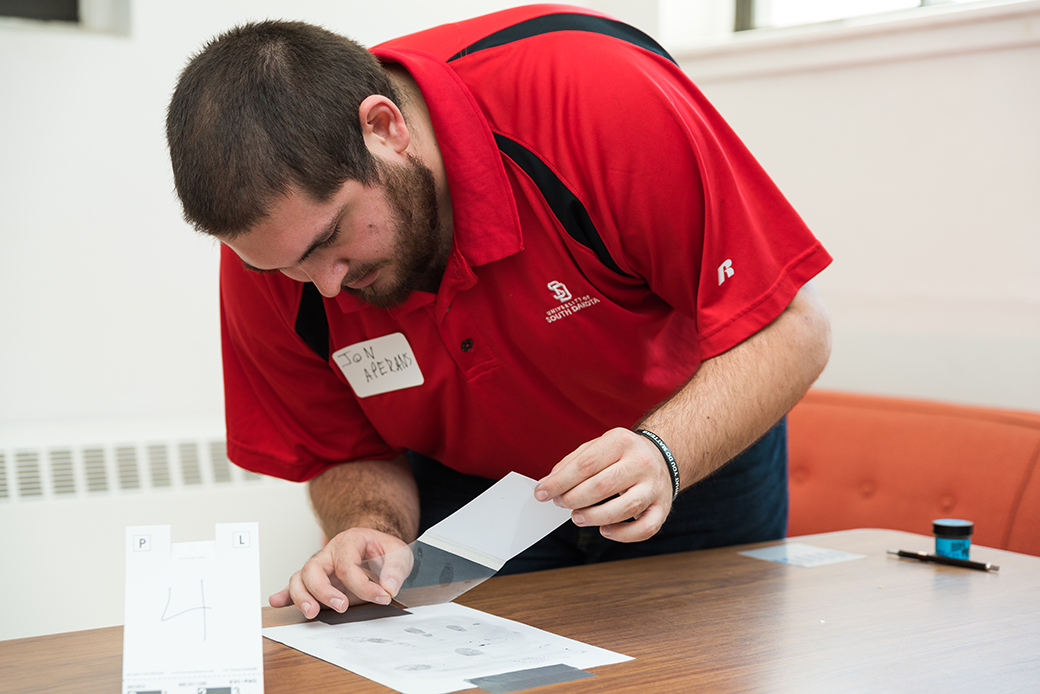
Criminal justice students sharpen skills at CSI Competition & Polygraph event
In a dusty basement room, USD students work tirelessly to solve a grizzly murder. There’s a red stain on the floor, a table lies on its side. The victim lies motionless on the floor. It’s imperative that no evidence is left undocumented.
This isn’t a scene from the CSI television show, but one that criminal justice students witnessed Saturday during USD CSI Competition & Polygraph event.
Agents from the Division of Criminal Investigation (DCI), the FBI, local law enforcement officials and USD’s criminal justice program all participated in the event, which consisted of a class, a competition and a polygraph examination.
While the class was open to the public, the competition and polygraph examination were reserved for USD students.
The event began with DCI agents presenting the basics of crime scene processing in a public class. Participants were taught how to secure a crime scene, evaluate, locate, collect and properly document evidence, take crime scene photos and accurately measure the crime scene.
“What I liked the most about the class was that they would stop and do demonstrations,” said sophomore Maria Starner, a criminal justice major.
Agents also showed how to use dental stone to make a caste of shoe prints, which is one of the tasks students had an opportunity to try during the competition portion. Super glue was revealed to be a helpful tool in preserving fingerprints and magnetic powder was useful in uncovering fingerprints that the agents had left on paper. Another demonstration showed how to use mikrosil, a silicone putty, to obtain tool marks.
After the crash course, seven students who volunteered to be polygraph subjects were taken to the crime scenes. While there, a few of these subjects were randomly assigned to steal 20 dollars from the crime scene. This was an important step, as professional DCI polygraph examiners would later be trying to deduce which subjects had stolen the money.
Once these additional crimes had been committed, around 35 other students assigned to seven different teams headed to the crime scenes in Farber and Dakota Hall for the CSI competition. These teams were to utilize the information presented in the earlier class to process the crime scene. The crime scenes involved a fake body, bodily fluids and additional evidence.
Team members had to process evidence, theorize what occurred, take pictures and draw scale drawings of the scene.
Polygraph subjects were taken to separate rooms in the law school and were taught the basics of polygraph examinations.
“I learned a lot about it and how it doesn’t measure your nerves, it measures other things like breathing, blood pressure and sweat,” Starner said.
Participants were hooked up to multiple instruments in order to obtain an accurate readings.
“The only time I had ever seen [a polygraph exam] was on TV, and it was nothing like that at all,” said senior Caitlyn Bagley, a criminal justice major. “My examiner made sure I understood every question that I was asked and that I was comfortable during the entire process.”
Bagley said she learned many interesting facts throughout the process.
“I had no idea that the motion pads on the floor were so sensitive that they can even detect a heartbeat in boots construction workers wear,” Bagley said.
Once the polygraph examinations were completed and the teams had finished processing, the results of both were presented.
Although all the teams did well, only one team was awarded prizes. The winning team included Chelsea Gilbertson, Jong-Ihl Jeong, Dylan Miller and Austin Rommeling, all CJUS majors.
After the event, students were free to continue networking with the agents and law enforcement officials.
“In complete honesty, I did not want to sign up and I dragged myself to the competition, expecting to simply be wasting a Saturday,” Gilbertson said. “I didn’t expect the event to be so fun or interesting, and I couldn’t have asked for a better experience.”

